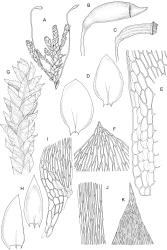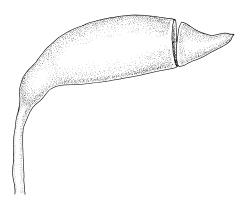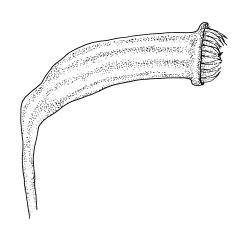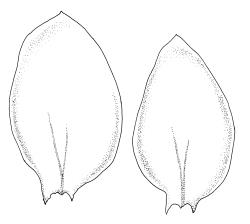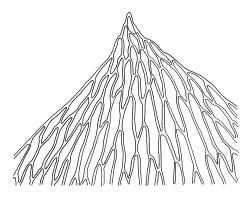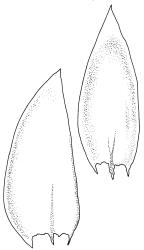- ≡ Hypnum lamprostachys Hampe, Linnaea 30: 639 (1860)
Plants medium-sized, pale- or yellow-green, glossy both fresh and dry. Shoots mostly complanate to ± julaceous. Stems prostrate, usually c. 20–60 mm, irregularly branched, beset with scattered, sparse fascicles of smooth brown rhizoids, in cross-section with a small and indistinct central strand. Branches usually ascendant, some often somewhat flagelliferous. Leaves closely spaced, weakly to strongly asymmetric, smooth or wrinkled when dry, strongly or sometimes weakly concave, ovate (sometimes broadly), acute or obtuse at apex, entire or with a few apical denticulations, plane throughout or broadly inrolled on one margin for up to ⅔ its length, decurrent, (1.65–)1.9–2.5(–2.7) × c. 0.65–1.3 mm (unflattened); mid laminal cells linear to linear-rhomboid, smooth, thin-walled, and pointed at ends, variable in size, mostly 80–185(–225) × 5–12 µm, becoming shorter and broader but not porose near base; alar cells inflated, mostly oblong and thin-walled, forming a narrow to broad (to c. 150 µm wide) decurrency that usually strips off with leaves. Costa forked just above base, the longer branch extending ¼ to ½ the leaf length. Asexual propagulae absent.
Autoicous. Perichaetia scattered, c. 1 mm long, the leaves erect, ± tubulose, ecostate. Perigonia c. 0.3 mm scattered on stems but often numerous near stem base, the bracts broadly ovate. Setae slender and flexuose, red, dextrorse, c. 15–25 mm; capsules inclined to nearly horizontal, cylindric, curved, weakly sulcate and constricted below the mouth when dry, smooth when moist, with a distinct and wrinkled neck, (1.5–)2.0–2.5 mm, pale yellow-brown; exothecial cells firm-walled, mostly oblong; stomata conspicuous in neck, superficial; operculum conic. Peristome as for genus, pale; cilia mostly 2, nodose. Spores 8–15 µm, appearing smooth.
Ireland 1992, figs 1–8 (as P. novae-seelandiae); Malcolm & Malcolm 2003, p. 51 (as P. novaeseelandiae); Meagher & Fuhrer 2003, p. 45; Seppelt 2004, fig. 86; Seppelt et al. 2013, pl. 16 (reproduced in Australian Mosses Online).
Confusion sometimes occurs with Sauloma tenella, particularly when sterile. P. lamprostachys has erect leaf apices, whereas in S. tenella the leaf apex is usually somewhat reflexed. The absence of basal decurrencies and the generally weaker costae in Sauloma can facilitate differentiation. The septate fusiform gemmae of Sauloma are highly diagnostic, but are not always present.
This species is also sometimes confused with Rhynchostegium tenuifolium. Plagiothecium lamprostachys differs from that species by having entire margins, clearly forked costae, pale exostome teeth, and conic (not rostrate) opercula.
NI: N Auckland, offshore islands only (Hen I.), Gisborne (Toatoa, Maunga Pōhatu, near Lake Waikaremoana), Taranaki (Mt Taranaki), Wellington; SI: Nelson, Canterbury, Westland, Otago, Southland. Recorded from C by Vitt 1974 (as P. laetum) and from M by Seppelt 2004. No material has been confirmed from Hawke’s Bay or Marlborough L.D.
Australasian. Tasmania* and mainland Australia (Vic.*). Klazenga (2012) recorded it from N.S.W.
Most often occurring in rock crevices, on outcrops, or in boulder fields (on greywacke, granite, schist, or basalt). Less frequently in other habitats, including trunks of Lophozonia menziesii, rotting logs, soil banks, humus over rock (apparently including limestone), and on the bases of snow-tussocks (as at Mt Arthur, Nelson L.D. and the Craigieburn Range, Canterbury L.D.). Mostly occurring in subalpine shrubland or in alpine areas, but also present in forest (mostly Fuscospora solandri s.l. or Lophozonia menziesii dominated). On Macquarie I. it occurs on litter and peat amongst grasses and rushes (R.D. Seppelt, pers. comm., 24 May 2018). On the North I. documented from low elevation to at least 900 m (Tararua Range, Wellington L.D.) and on the South I. documented from 150 m (vicinity Borland Lodge, Southland L.D.) to c. 1980 m (St Bathans Range, Otago L.D.). Frequently associated moss species include Bartramia papillata, Catagonium politum, Distichophyllum pulchellum, D. rotundifolium, Fallaciella gracilis, Leptotheca gaudichaudii, Lepyrodon lagurus, Pyrrhobryum bifarium, and Thuidiopsis furfurosa.




